It’s Week 3 of the Essex Coastal Challenge and we’re exploring the Blackwater and Colne, its coastal communities, and our precious wildlife that we share our shores with.
Welcome to the story of Essex’s beautiful coast. We finished last week at the remote and pancake-flat wilderness of the Dengie Peninsula; this week, the coastal landscape becomes more urban as we explore coastal towns and villages, and nature havens dotted amongst them.

Bradwell Shell Bank [1]
We have one more stop on the Dengie before we wave goodbye to its restful spaciousness and vast open skies – Bradwell Shell Bank, a nature reserve made up of cockle and oyster shells formed by years of tidal currents. During autumn and winter, the reserve will see around 20,000 roosting wading birds here; during summer it’s an especially important habitat for breeding oystercatchers and ringed plover. Hear the screech of raptors flying overhead including short-eared owls and kestrels. Look out to sea, over mud and sandflats, to the Dengie National Nature Reserve: an internationally important site for overwintering waders especially grey plover, knot and bar-tailed godwit. The saltmarsh is carpeted in summer flowers this week including yellow-horned poppy, samphire, and sea holly, while swifts and barn swallows fly overhead. It is truly stunning.
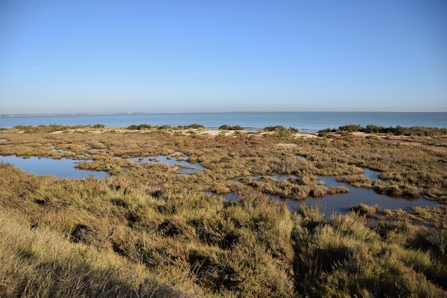
But sadly our litter, including fishing gear, cotton bud sticks and balloons, are regularly found on site so we organise monthly litter picks to protect the precious creatures that call our sea their home. Think what we could achieve if we all did our bit to protect our beautiful coastline and marine wildlife.
Tollesbury Wick nature reserve [2]
Pass the great looming hulk of Bradwell Power Station at the mouth of the River Blackwater and the small yachts peppered around privately owned Osea Island. Reach the waterfront of the attractive market town of Maldon; the surrounding area is rich in history of Viking battles lost and won. When you’re ready to leave Maldon, travel on to Tollesbury Wick nature reserve: its sea wall bisects this stunning freshwater grazing marsh and the glorious saltmarsh; accompanied by an eclectic backdrop of the infamous red lightship and the former pirate radio ship, Ross Revenge. Keep your eyes peeled for Essex Wildlife Trust’s flying flock of sheep, cattle and Exmoor ponies, who help manage the freshwater marsh in the most sustainable way possible. Spot clouded yellow butterflies that flutter above the grassland and gaze upon a majestic marsh harrier scanning the marshes and reedbeds.
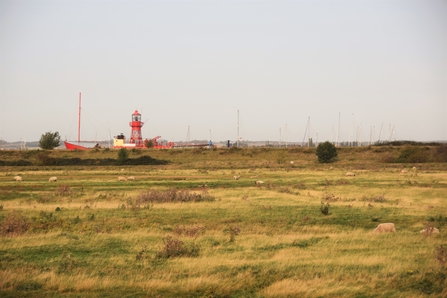
Discover Tollesbury Wick’s impressive shingle spit - one of five priority locations for Essex Wildlife Trust and the RSPB’s collaborative Share our Shores project, which protects Essex’s most threatened beach nesting birds. Throughout the spring and summer, areas like this provide critical nesting sites for chattering little terns (that weigh no more than a tennis ball), ringed plover and brightly beaked oystercatchers. Sadly, these iconic Essex birds are under increasing pressure from human disturbance; but everyone can help – by knowing where potential breeding locations are; respecting zoned off areas; avoiding disturbance by boat; backing away if you disturb a breeding species; and raising awareness. Let’s work together to share our shores and secure a bright future for our coastal wildlife.
Abbotts Hall Farm [3]
Leave the village of Tollesbury, a coastal hidden gem; pass tidal creeks with gently lapping waves through to Abbotts Hall Farm the main offices of Essex Wildlife Trust. Formerly a working farm and sitting at the heart of the Blackwater Estuary between the RSPB’s Old Hall Marshes and the National Trust’s Copt Hall, this 300 hectare coastal reserve is a vital piece of the landscape-scale jigsaw to connect our coastline for wildlife. Almost 20 years ago, its seawall was breached in five locations to create 70 hectares of valuable mudflat and saltmarsh that today attract curlew, redshank and goldeneye; while bass, mullet and gobies feed and find refuge in the twists and turns of the saltmarsh channels. The sea hog’s fennel you can see around you provides vital sustenance for the rare fisher’s estuarine moth, on the wing in the autumn thanks to a successful re-introduction project. While taking in the views of the saltmarsh, you can observe our restoration work to stabilise them from erosion.
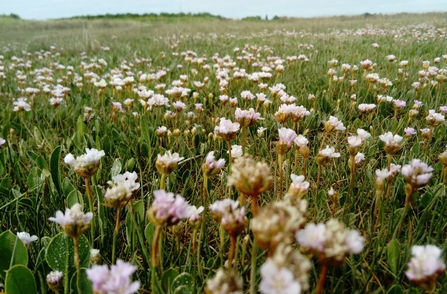
On your left is nearly 60 hectares of formerly arable fields that have been sown with a combination of nectar-rich seed mixes and wild bird cover that provides this blooming display, currently alive with insects, while yellowhammer and skylark call out from within. The cessation of farming practices after the 2019 harvest means Abbotts Hall Farm has started its next transformation process to create a wilder landscape. Look to the skies you might see the ghostly figure of a barn owl swoop past or a kestrel emerge from one of our nest boxes.
Fingringhoe Wick Nature Reserve [4]
Look out to the distance and you can see Mersea Island, a popular spot for family holidays and Britain’s most easterly inhabited island. It’s famous for its oyster fishing industry, established by the Romans over 2,000 years ago. Find yourself now on the River Colne, that flows right through the centre of Essex’s second largest town after Southend, Colchester, about 6 miles inland. Historic and beautiful Colchester was once capital of Roman Britain. Before we reach it though, there’s another very special haven for wildlife: Fingringhoe Wick Nature Reserve, Essex Wildlife Trust’s first nature reserve (1961). It is a site of transformation and recovery - when Essex Wildlife Trust bought the site, it was a barren lunar landscape (having been used for sand and gravel extraction) and some very dedicated people developed it into the wonderful mosaic of different habitats we see today: grassland, gorse heathland, reedbeds, ponds, meadows and scrub. The 200 hectare nature reserve now hosts up to 200 species of birds (and is one of the best sites in the country for nightingales in spring), 27 species of dragonfly and damselfly, 24 species of butterfly, 350 species of flowering plants, as well as adders, badgers and many other animals.
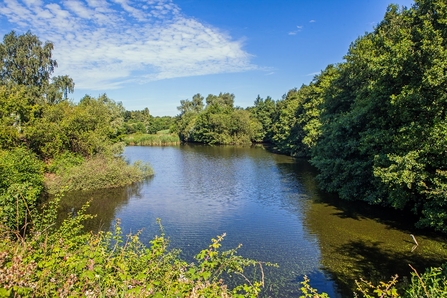
Take a walk through the reserve to sit in Margaret Hide, with panoramic views over the ‘intertidal area’, where the seawall was breached six years ago to create 22 hectares of mudflat and saltmarsh that now sequesters and stores carbon, while acting as a flood defense and improving water quality. With over 85% of saltmarsh habitat being lost in the UK in the last 100 years, we need more ambitious restoration and creation projects like this.
Back on dry land, stroll along grassy riverside paths to Colchester; the river will continue all the way to Halstead, but we still have a lot of the coast to explore! Enjoy the waterfronts at Rowhedge and Wivenhoe that sit on opposite banks of the River Colne. A cormorant sites on top of a flagpole and lazily watches walkers, family cyclists, canoeists and lunch-break runners from nearby Colchester University, enjoying the sunshine. The miles of deserted paths of the Dengie Peninsula feel very far away now.
Howlands Marsh nature reserve [5]
Walking along the riverbank from Wivenhoe, on the east bank of the Colne, you’ll find yourself at another little seaside town with a line of colourful beach huts and plenty of sailing boats: Brightlingsea. Little steam trains used to puff right by the path you’ve just followed, towards the coast. But that comforting and restful marshy remoteness that has now become so familiar is not far away: this time, it’s Howlands Marsh nature reserve, a large freshwater grazing marsh and wildlife haven reclaimed from the sea many years ago by an entirely handmade sea wall.
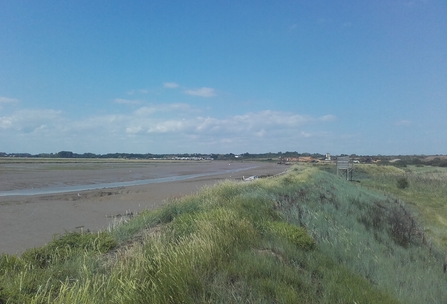
Tranquil Howlands Marsh acts as an important part of the puzzle that makes up grazing marshes in the wider landscape, giving different bird species freedom to roam, feed, rest and raise young across the area. Until July its grazing cattle are forbidden entry to the “summer grazing section”, by a large freshwater lagoon, to allow nesting birds the peace to raise young.
Colne Point nature reserve [6]
Pass St Osyth to Point Clear, which marks the beginning of a long stretch of open sea right up to Walton-on-the-Naze – and the beginning of a long stretch of static caravans! We’re on the Tendring peninsular; and right at the tip where it meets the Colne estuary, find 680-acre Colne Point nature reserve, one of our first and one of our biggest nature reserves. It’s also protected by several designations: it’s officially a Site of Special Scientific Interest, a Special Area of Conservation, a Special Protection Area, a Ramsar site and part of the Colne Estuary National Nature Reserve. It’s remote and exposed; it can be perilous to visitors due to rapidly changing weather and tides, so visiting this reserve is normally restricted to members and permit holders.
Colne Point is one of our most important reserves for its biodiversity.
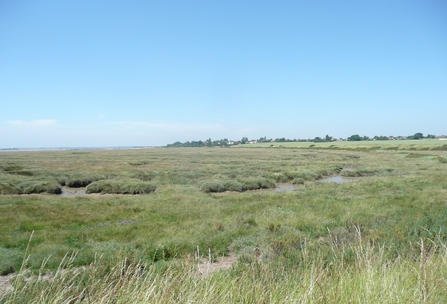
When the national coastal path is complete, it will pass along the inland boundary seawalls allowing us to see this extensive area of saltmarsh and its many flying visitors. Colne Point is noted for its passage migrant birds and the mudflats attract a lot of waders and wildfowl. Both grey and common seals are occasionally seen here and the odd porpoise can be observed feeding in the waters. The ridges of the saltmarsh are bouncing with grey bush crickets and mottled grasshoppers. This week, the sea aster mining bees are starting to emerge in huge numbers.
Pause here and rest
We’ve covered a lot of ground this week! Once again, we end by looking out to onto the water – specifically, onto another (Essex’s first) Marine Conservation Zone (MCZ) after Kentish Knock in Week 1: the Blackwater, Crouch, Roach and Colne Estuaries MCZ [6]. We’ll admit, it’s not a very snappy title… but it’s very, very special for wildlife. At 284km2, it’s the largest inshore MCZ in the UK – and we’ve actually been looking out onto it throughout our coastal journey this week! It is designated to protect the native oyster and the oyster bed reefs it creates, which in turn provides a home, feeding ground and nursery area for a plethora of fish. The native oyster’s ability to improve water quality and reduce nitrate levels further improves the estuarine ecosystem – benefitting wildlife and us! You can look for oyster shells all year round. Have you found any this week? But don’t get confused with the Pacific oyster: these are invasive non-native species.
Shockingly, there are fewer than 5% of native oysters remaining in Europe compared to historic levels. Essex Wildlife Trust is proud to be a partner of the Essex Native Oyster Restoration Initiative (ENORI), aiming for self-sustaining populations of native oysters that provide ecosystem services, increase biodiversity and have sustainable fisheries in Essex - all whilst recognising the cultural and heritage importance of the native oyster. Innovative restoration work is taking place in the Blackwater, including adding shell for young oysters to recruit onto so that they can grow, and adding reproductively mature oysters into the population.
Highly Protected Marine Areas (HPMAs) are a vital component of our Marine Protected Area network and The Wildlife Trusts are calling for the government to commit to an ambitious HPMA delivery plan within a year.
Add your name to support HPMAs
Become a Friend of the Marine Conservation Zones
The sun is setting across Colne Point’s broad horizon now. Even this far north, you may just be able to make out the Kentish coast… and here, we wave goodbye to Week 3 of the Essex Coastal Challenge.

